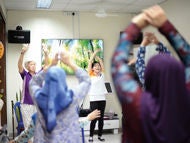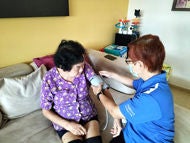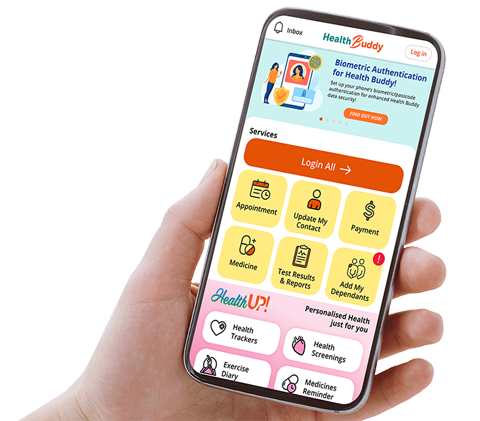What is - Development
Witnessing your child's development is an amazing and unique experience. Watching him progress from the helplessness of babyhood to maturing independence will overflow you with joy and relief.
However, anxiety and even apprehension inevitably creeps in every now and then in the course of his development. The question now: "Is my child developing normally"? Providing yourself with information about developmental phases will lessen some of that stress.
However, it is essential to keep in mind that no two children develop the same way. Every child is an individual. For every developmental milestone, there is a normal range in which a child may reach that milestone. Consult your doctor if you observe that your child does not develop according to the general pattern.
Below is a general list of some of the things you might see children doing at different ages, but these are NOT precise guidelines. There are many different normal paces and patterns of development.
Newborns
- The physical development of the infant begins at the head, then progresses to other parts of the body
- Newborn babies are usually sleepy in the first few days after birth, gradually giving way to longer periods of alert wakefulness and physical activity
- He may shift his eyes towards nearby sources of continued sound like cooing. It is common for babies to display startled reaction to sudden loud noises
- Unable to raise head. Head falls backwards if pulled to sit.
- Opens eye when held in an upright position.
- Bonds with mother. Smiles at mother.
- Respond to high-pitched tones by moving his limbs.
- Hands are fisted, the arms are flexed
At 1 Month
- The baby still sleeps most of the time when not being fed or handled. His head still tends to fall to one side when he is in a lying position.
- He moves his arms and legs in a jerky manner and the arms are usually more active
- His head still falls loosely when lifted but he makes attempts to hold it erect
- He is able to follow the slow movement of an object (held six to ten inches from his face) with his eyes and will make slight movements of the head. He will also move his eyes and head towards the source of sound or voice.
- At this stage, the baby watches nearby faces with an increasingly alert expression during feeding and play, progressing to social smiles and responsive vocalisations at about five to six weeks
At 3 Months
- The baby is able to hold his head in midline and the movements of his arms and legs are smoother and more continuous
- He can bring his hands from his side to midline and kick his legs alternatively, or sometimes, together
- Raises head and chest when lying on stomach
- Supports upper body with arms when lying on stomach
- At this stage, the baby's visual alertness increases, especially to nearby human faces. He attentively follows movements around him as well as movement of his own hands at play.
- The baby now enjoys bathing and other caring routines and begins to react to pleasurable and familiar situation with smiles, increased vocalising of "coos" and "gaas" and excited movements
- Establishes eye contact
- Takes increasing interest in his surroundings
- Beginning to vocalise. Smile in response to speech
- Turns head toward direction of sound
At 6 Months
- The baby is able to raise his head to look at his feet and lift the legs up to grasp his foot
- When his hands are held, he pulls to sit himself with the head erect. He may be able to sit alone momentarily. When held in a sitting position, his head is erect, his back straight and he turns his head from side to side to look around
- When placed on the tummy, he supports himself on his straightened arms and palms
- When held standing, he no longer sags at the knee and will bounce up and down actively
- The baby's eyes follow the movements and activities around him attentively. He can focus on small objects held within six to twelve inches of him and stretches out to grasp them with both hands
- He takes everything to his mouth at his stage
- He can grasp a rattle and shake it deliberately to make a sound
- Able to transfer objects from one hand to the other
- At this stage, the baby vocalises with a wider vocabulary (or) more syllables, laughs, chuckles, squeals aloud at play, and screams with annoyance. He can recognise familiar voices immediately
- Makes sounds resembling one-syllable words (example: da-da, ba-ba)
- Starts to imitate sounds
- Recognises parents
- Begins to fear strangers
- Beginning of teething
At 9 Months
- The baby can sit alone for 10 - 15 minutes on the floor and leans forward to pick up toys without losing balance
- He progresses on the floor by rolling or squirming and attempts to crawl
- He is able to pull to stand for a few moments while holding onto support but falls backwards with a bump as he cannot lower himself properly
- When held standing, he steps purposefully alternating his feet
- The baby becomes visually very attentive to people and happenings in his environment
- He is also keenly attentive to sounds and voices, and he vocalises purposefully with friendliness or in annoyance. At this stage, he is beginning to understand simple terms like "no no" and "bye bye"
- He starts poking at objects with his index finger and picks things up between the fingers and thumb in a pincer grasp. He holds objects, bites a biscuit and tries to help with feeding
- He walks around furniture by stepping sideways, and walks forward and sideways with one or both hands held. Some babies may stand or even walk alone for a few seconds
- The baby can pick up fine objects like sweets, crumbs, or strings using a neat pincer grasp
- He drops and throws toys deliberately and watches them fall to the ground
- He can point with his index finger at objects that he wishes to handle or happenings which interest him
- At this stage, he knows and responds immediately to his own name and understands several words and instructions like "Give to daddy" or "Come to mummy". He imitates adult vocalisations and is sometimes able to form words with gleeful enthusiasm
- The baby makes attempts to help with feeding and dressing. He drools and puts things into his mouth less often
- He attempts to copy more and more of your gestures and learns how to identify the use
- Plays interactive games, such as peek-a-boo and pat-a-cake
At 12 Months
- Pull to stand. Walk with help or alone. Sit down without help
- Puts block in cup. Turn through the pages of a book by flipping many at a time
- Points to objects with index finger. Picks up small objects
- Responds to his or her name. Responds to “no”
- Understands several words and simple commands
- Can say mamma, papa, and at least one or two other words
- Drink from a cup. Imitates others
- Waves goodbye
- May develop attachment to a toy or object
- Experiences separation anxiety and may cling to parents
At 18 Months
- Runs with a lack of coordination and falls frequently
- Walks up stairs while holding on with one hand
- Can build a tower of two to four blocks
- Can use a spoon and cup with help to feed himself
- Imitates scribbling. Can turn two or three pages of a book at a time
- Shows affection
- Listens to a story or looks at pictures
- Can say 10 or more words when asked
- Explores environment
- Identifies one or more parts of the body
- Understands and is able to point to and identify common objects
- Imitates domestic activities
- Is able to take off some clothing items, such as gloves, hats, and socks
- Begins to feel a sense of ownership, identifying people and objects by saying "my"
- Attains bowel control
Development – 2 To 6 Years
Although no two children are exactly alike, distinct development patterns can be observed in your children aged two to six years old.
The Trying 2s
- Walks alone. Rises without using hands. Able to run. Walks up and down stairs two feet per step. Kicks a ball. Climbs onto and down from furniture unassisted
- Builds tower of six cubes. Turns picture book pages one at a time. Scribbles on his or her own. Might use one hand more often than the other
- Able to put on simple clothes without help (often better at removing clothes than putting them on). Dry by day.
- Able to communicate needs such as thirst, hunger, need to use the restroom
- Joins two to three words in sentences. Vocabulary has increased to about 50 - 300 words
- Recognizes details in pictures. Knows body parts.
- Uses own name to refer to self.
- Understand two-step command ("give me the ball and then get your shoes")
- Imitates behaviour of others, especially adults and older children
- Begins make-believe play
- Demonstrates increasing independence
- Begins to show defiant behaviour
- Negativism: "No, No, No….!" is a very common response for children at this age
- Temper Tantrums: Throw temper tantrums when you don’t give them what they want, but get over them very quickly too.
- Great Curiosity: They like to explore - test things, taste them, press them and squeeze them.
- Possessiveness And Destructiveness: They do not like to share their things and can get rough with toys when asserting their ownership. They also like to investigate everything, so toys should not be easily broken or torn apart.
Tips For Handling 2-Year-Olds:
Two-year-olds are at a stage of exploring the world around them and are trying to master skills on their own. They seek to attain independence and to satisfy their curiosity. Thus, when they are upset, they give vent to outbursts of tantrums and anger.
Try The Following:
- Give plenty of opportunity for exploration in their environment. Provide playthings they can touch, press and taste. Equip them with toys that stimulate imagination and promote exploration.
- Distract the child when he is frustrated by giving other activities. Or help him if he can't handle a certain task.
- Provide durable toys that are not easily broken
- Create a game out of the task you would like him to do if the child answers with a "No!"
The Trusting 3s
- Can briefly balance on one foot. May walk up the stairs with alternating feet (without holding the rail). Can pedal a tricycle
- Copies circle. Imitates cross and draws man on request. Builds tower of 8 cubes. Has good pencil control. Can cut paper with scissors. Can thread large beads on a string.
- Can sort objects into simple categories. Recognises and identifies almost all common objects and pictures
- Has a vocabulary of many hundreds of words. Composes sentences of three to four words. Uses plurals and pronouns (he/she). Understands concept of “mine” and “his/hers” . Frequently asks questions
- Knows own name, age, and gender (boy/girl)
- Strangers can understand most of her words
- Can dress self, only requiring assistance with laces, buttons, and other fasteners in awkward places. Feeds self without difficulty. May have daytime control over bowel and bladder functions (may have night time control as well)
- Anxious To Please: Children obey the rules eagerly at this age because they like to please adults to obtain approval and acceptance.
- Cooperative: They enjoy following orders and working with other children. They also like to share now, because they are very interested in other people.
- Very Energetic: They are on the go almost every minute of the day and tire themselves out easily.
- Highly Imaginative: They exist in a world of make-believe and are not yet able to distinguish between the real and the imaginary.
Tips For Handling 3-Year-Olds
- Praise the child for work well done, for obeying and for helping out
- Provide active games and fun for the child, but be sure to give him rest periods throughout the day
- Give time and materials for imaginative play.
- Organize cooperative activities for the child and his siblings, and with nearby children
- Reward him for working together with others
The Frustrating 4s
- Hops and stands on one foot up to five seconds. Kicks ball forward. Catches bounced ball most of the time.Throws a ball overhand with coordination
- Builds a tower of 10 cubes. Draws circles and squares. Draws a person with two to four body parts. Uses scissors. Begins to copy some capital letters
- Has a vocabulary of more than 1,000 words. Easily composes sentences of four or five words
- Understands the concept of counting and may know a few numbers
- Follows three-part commands
- Recalls parts of a story
- Understands the concepts of “same” and “different”
- Argues with other children. Plans games co-operatively.
- Dresses and undresses with assistance. Attends to own toilet needs.
- Inquisitive: This is the age of many questions. Even when answers are given, the 4-year-old continues to ask "Why?"
- Talkative: Because of their increasing capacity for language, children have a tendency to speak constantly.
- Emotionally Unpredictable:At 4, children can and often burst into laughter and tears at the same time! There are also sudden bouts of anger but the tempests are over quickly.
- Lively And Sociable:Full of energy and life, they enjoy being with other people now!
- High Motor Drive: Their need for muscular movement drives 4-year-olds to constant activities.
Tips For Handling 4-Year-Olds
- Encourage the child to askquestions. If you don't have the answer, find out the answer together with the child by looking up an encyclopedia, visiting the local library etc.
- Promote plenty of large motor skill activities. Allow them to climb, swing, ride a bicycle, jump etc. Be sure to take safety precautions.
- Talk to your child, read to your child. Build his vocabulary skills. Let him to take part in your conversations.
- Give opportunities for the child to have social activities. Let him invite friends home for a party, or have a popcorn night.
The Fascinating 5s
- Skipping, jumping, and hopping with good balance. Maintaining balance while standing on one foot with eyes closed. Well developed ball skills.
- Draws person with body and copies a triangle. Colors pictures carefully. Writes name. Prints some letters
- Vocabulary increasing to over 2,000 words. Speaks sentences of more than five words.
- Talks about the past, present and future with a good sense of time.
- Dresses and undresses alone. Shows caring attitudes towards others. Copes well with personal needs.
- Aware of gender
- Able to distinguish fantasy from reality
- Language Skills: As they are good in language skills now, children love to talk, tell stories and question adults.
- High Initiative: Usually, they want to start a conversation or to try new things.
- Vigorous And Noisy Group Games: Having a group of friends of their own age. Chooses own friends.
- Need for Approval: The approval of being "good boy" or "good girl" is all-important at this stage, so there is a definite desire to cooperate with both parents and teachers.
- Sense of Responsibility: They feel "grown-up" when they do little tasks and duties and are always keen to help mum and dad do things.
Tips For Handling 5-Year-Olds
- Give some time for conversation with your child. Read stories together. Encourage them to tell stories or share jokes with one another.
- Distinguish good work and compensate them appropriately.
- Organize games for them and do support them to join in group games. Set aside watching TV and get them out for the exercise they need.
- Teach children to be responsible in the home such as setting the table, drying dishes, picking up toys etc.
The Sociable 6s
- Learns to skip with rope. Copies a diamond. Knows right from left and number of fingers. Ties shoe laces.
- Draws with precision and to detail. Developing reading skills well. May write independently.
- Talk fluently and with confidence.
- Short Attention Span:Easily distracted, some children at this age lacks concentration on any one task.
- Highly Active And Restless:Fidgety and restless, they are full of energy that they simply can't sit still. They are always involved in active play like running, jumping and tugging.
- Eager To Learn:Everything is interesting to them. Reading books, enacting stories and watching cartoons are their favorite activities.
- Highly Competitive: They are eager to participate in games and play and are very sensitive about their performance.
- Strong Gender Affinity: There is a strong preference for friends and playmates of the same sex at this stage.
Tips For Handling 6-Year-Olds
- Develop in your child an interest in nature.
- Introduce lots of books, tapes, songs and educational videos to your child.
- Allow time for outdoor activities and things that hold his interests.
- Teach your child how to play and participate in group games. Highlight the values of team effort, group spirit and having a good time rather than the significance of winning.
The information provided is not intended as medical advice. Terms of use. Information provided by SingHealth.
Get to know our doctors at SingHealth Hospitals in Singapore.
Get to know our doctors at SingHealth Hospitals in Singapore. here.




















